Abstract
The study of the Bahía Asunción earthquake swarm is important for two reasons. First, the earthquakes are clear evidence of present activity along the zone of deformation on the Pacific margin of Baja California. The swarm, with earthquakes of magnitude M w of up to 5.0, occurred on the coastline of the peninsula, showing that the Tosco-Abreojos zone of deformation is wider than previously thought. Second, the larger earthquakes in the swarm caused some damage and much concern in Bahía Asunción, a small town located in the zone of epicenters. We relocated the larger earthquakes with regional and/or local seismic data. Our results put the earthquake sources below the urban area of Bahía Asunción, at 40–50 km to the north of the teleseismically determined epicenters. In addition, these new locations are in the area of epicenters of many smaller events that were located with data from local temporary stations. This area trends in an E–W direction and has dimensions of approximately 15 km by 10 km. Most earthquakes had sources at depths that are between 4 and 9 km. A composite focal mechanism for the smaller earthquakes indicated right-lateral strike–slip motion and pure-normal faulting occurred during this swarm. Interestingly, the ANSS earthquake catalog of the United States Geological Survey (USGS) reported each one of these faulting styles for two large events of the swarm, with one of these earthquakes occurring 2 days before the other one. We associate the earthquake with strike–slip mechanism with the San Roque Fault, and the earthquake with the normal faulting style with the Asunción Fault. However, there is need of further study to verify this possible relation between the faults and the earthquakes. In addition, we recorded peak accelerations of up to 0.63g with an accelerometer installed in Bahía Asunción. At this site, an earthquake of M w 4.9 produced those high values at a distance of 4.1 km. We also used the acceleration dataset from this site to estimate the linear response of sediments lying beneath the station. The resulting average amplification function has a fundamental resonance frequency of about 5 Hz and shows amplification factors of 2–4 for motions at frequencies in the range 2–8 Hz. A comparison of this amplification function with the response of soils to shaking from larger events shows that above 20 Hz the amplification of motion in the larger events decreases relative to the weak-motion response.










Similar content being viewed by others
References
Borcherdt, R. D. (1994). Estimates of Site-Dependent Response Spectra for Design (Methodology and Justification). Earthquake Spectra, vol. 10(4), pp. 617–653.
Brothers, D., A. Harding, A. González-Fernández, W. S. Holbrook, G. Kent, N. Driscoll, J. Fletcher, D. Lizarralde, P. Umhoefer and G. Axen (2012). Farallon slab detachment and deformation of the Magdalena Shelf, southern Baja California, Geophys. Res. Lett., 39, L09307, doi:10.1029/2011GL050828.
Castro, R. R., C. Valdés-González, P. Shearer, V. Wong, L. Astiz, F. Vernon, A. Pérez-Vertti, and A. Mendoza (2011). The 3 August 2009 M w 6.9 Canal de Ballenas Region, Gulf of California, Earthquake and Its Aftershocks. Bull. Seism. Soc. Am., 101, No. 3, pp. 929–939, doi:10.1785/0120100154.
Clayton, R.W., J. Trampert, C. Rebollar, J. Ritsema, P. Persaud, H. Paulssen, X. Pérez-Campos, A. Wettum, A. Pérez-Vertti, F. DiLuccio (2004). The NARS-Baja Seismic Array in the Gulf of California Rift Zone. Margins Newsletter, No. 13, 1–4.
DeMets, C. A. (1995). Reappraisal of seafloor spreading lineations in the Gulf of California: implications for the transfer of Baja California to the Pacific plate and estimates of Pacific-North America motion, Geophys. Res. Lett., 22, 3545–3548.
DeMets, C. A. and Dixon, T. H. (1999). New kinematic models for Pacific-North America motion from 3 Ma to present, I: Evidence for steady motion and biases in the NUVEL-1A model, Geophysical Research Letters, 26, 1921–1924.
Fletcher, J. M., and L. Munguía (2000). Active continental rifting in southern Baja California, Mexico: implications for plate motion partitioning and the transition to sea floor spreading in the Gulf of California, Tectonics, 19, No. 6, 1107–1123.
Fletcher, J.M., M. Grove, D. Kimbrough, O. Lovera, and G. E. Gehrels (2007). Ridge-trench interactions and the Neogene tectonic evolution of the Magdalena Shelf and southern Gulf of California: Insights from detrital zircon U-Pb ages from the Magdalena fan and adjacent areas. Geol. Soc. Am. Bull., 119; no. 11/12; pp. 1313–1336; doi:10.1130/B26067.1.
Goff, J. A., E. A. Bergman, and S. C. Solomon (1987). Earthquake source mechanisms and transform fault tectonics in the Gulf of California, J. Geophys. Res., 92, 10,485–10,510.
Havskov, J., and L. Ottemöller (Editors) (2001). SEISAN: the earthquake analysis software for Windows, SOLARIS, and LINUX, Version 7.2. Manual, Institute of Solid Earth Physics, University of Bergen, Norway.
Lermo, J., and F. J. Chavez-Garcia (1993). Site effects evaluation using spectral ratios with only one station, Bull. Seism. Soc. Am. 83, no. 5, 1574–1594.
Lienert, B. R. E. and J. Havskov (1995). A computer program for locating earthquakes both locally and globally. Seismol. Res. Lett., 66:26–36.
Michaud, F., Sosson, M., Royer, J.-Y., Chabert, A., Bourgois, J., Calmus, T., Mortera, C., Bigot-Cormier, F., Bandy, W., Dyment, J., Pontoise, B., and Sichler, B. (2004), Motion partitioning between the Pacific plate, Baja California and the North America plate: The Tosco-Abreojos fault revisited: Geophysical Research Letters, v. 31, p. L08604, doi:10.1029/2004GL019665.
Michaud F, T. Calmus, M. Sosson, J-Y. Royer, J. Bourgois, A. Chabert, F. Bigot-Cormier, B. Bandy, C. Mortera-Gutiérrez (2005). La zona de falla Tosco-Abreojos: un sistema lateral derecho activo entre la placa Pacífico y la península de Baja California. Boletín de la Sociedad Geológica Mexicana. Tomo LVII, Núm. 1., pp. 53–63.
Michaud, F., Calmus, T., Royer, J.-Y., Sosson, M., Bandy, B., Mortera-Gutiérrez, C., Dyment, J., Bigot-Cormier, F., Chabert, A., and Bourgois, J. (2007), Right lateral active faulting between southern Baja California and the Pacific plate: The Tosco-Abreojos fault, In Alanis-Alvarez, S. A. and Nieto-Samaniego, A. F., eds., Celebrating the Centenary of the Geological Society of Mexico: Geological Society of America, special paper 422, pp. 287–300, doi:10.1130/2007.2422(09).
Michaud, F., Calmus, T., Ratzov, G., Royer, J.-Y., Sosson, M., Bigot-Cormier, F., Bandy, W. and Mortera-Gutiérrez, C. (2011). Active deformation along the southern end of the Tosco-Abreojos fault system: New insights from multibeam swath bathymetry. Pure Appl. Geophys., 168(8–9), 1363–1372, doi:10.1007/s00024-010-0193-y.
Munguía, L., M. Reichle, A. Reyes, R. Simons, and J. N. Brune (1977). Aftershocks of the 8 July, 1975 Canal de las Ballenas, Gulf of California, earthquake, Geophys. Res. Lett., 4, 507–509.
Munguía, L., M. González, S. Mayer, and A. Aguirre (2006). Seismicity and State of Stress in the La Paz–Los Cabos Region, Baja California Sur, Mexico. Bull. Seismol. Soc. Am., 96, No. 2, pp. 624–636, April 2006, doi:10.1785/0120050114.
Munguía, L., M. González, M. Navarro, T. Valdez, S. Mayer, A. Aguirre, V. Wong, and M. Luna (Submitted to PAGEOPH, 2015). A local seismic study at the central part of the Magdalena Shelf, in the Pacific margin of Baja California Sur, Mexico.
Nakamura, Y. (1989). A method for dynamic characteristics estimation of subsurface using microtremor on the ground surface, Quarterly Report of the Railway Technical Research Institute 30, no. 1, pp. 25–33.
Normark, W.R., J.E. Spencer, and J. Ingle (1987). Geology and Neogene history of the Pacific c continental margin of Baja California Sur, Mexico, in Scholl, D.W., et al., eds., Geology and resource potential of the continental margin of western North America and adjacent ocean basins—Beaufort Sea to Baja California: Houston, Texas, Circum-Pacific Counsel for Energy and Mineral Resources, Earth Science Series, 6, p. 449–472.
Ortlieb, L. (1991). Quaternary Vertical Movements along the Coasts of Baja California and Sonora. In: J. P. Dauphin and B. T. Simoneit (Eds.), The Gulf and Peninsular province of the Californias, Amer. Asoc. Petrol. Geol. Mem., 47, pp. 447–480.
Reichle, M. S., G. F. Sharman, and J. N. Brune (1976). Sonobuoy and teleseismic study of Gulf of California transform fault earthquake sequences. Bull. Seismol. Soc. Am., 66, No.5, pp. 1623 1641.
Salazar, C. R. M. (2014). Evidencias estructurales y sismo estratigráficas en la parte central de la plataforma Magdalena, margen occidental de Baja California a partir de sísmica de reflexión. MsC. thesis, 89 pp., Centro de Investigación Científica y de Educación Superior de Ensenada, B. C., Ensenada, B. C., México.
Seed, R. B., Chang, S. W., Dickenson, S. E., and Bray, J. D. (1997) “Site-Dependent Seismic Response Including Recent Strong Motion Data.” Proc., Special Session on Earthquake Geotechnical Engineering, XIV International Conf. On Soil Mechanics and Foundation Engineering, Hamburg, Germany, A. A. Balkema Publ., Sept. 6–12, pp. 125–134.
Spencer, J. E. and Normark, W. R. (1979). Tosco-Abreojos fault zone: A Neogene transform plate boundary within the Pacific margin of southern Baja California, Mexico. Geology, V. 7, pp. 554–557.
Acknowledgments
Financial support for this research was provided by Centro de Investigación Científica y de Educación Superior de Ensenada, B. C. (CICESE). We also want to express our gratitude to Guillermo Gutiérrez de Velasco, of CICESE at La Paz, Baja California Sur, Pedro G. Osuna López of H. XII Ayuntamiento de Mulegé, Luis Martínez Pozo, Subdelegate of Bahía Asunción, Mario Ramade of Federación de Cooperativas de Baja California, Managing personnel of Cooperativa Leyes de Reforma, Cesar Redona Camacho of Sociedad Cooperativa California en San Ignacio, Ramón Villa Villegas, Armando Naranjo Rivera of XIII District of Mulegé, David A. Maraver Romero of Servicio Geológico Mexicano (SGM), Antonio de Jesús Ceseña Moyrón of Seguridad Pública y Tránsito Municipal of Bahía Asunción, and to personnel of Civil Protección of Baja California Sur. We acknowledge Carlos Gutiérrez and technicians of Centro Nacional de Prevención de Desastres for providing some seismic data they collected in the epicentral area with an analog seismograph and two weak-motion digital stations. We appreciate the field service provided by Martín Romero to our analog stations. Many other people supported our study in different forms (technical support, economic funds, transportation vehicle, materials and accessories, etc.). Our deepest thanks to all. The authors would also like to acknowledge the work of Dr. William Bandy and two anonymous reviewers. Their in-depth reviews and constructive comments and suggestions were helpful in improving the manuscript.
Author information
Authors and Affiliations
Corresponding author
Rights and permissions
About this article
Cite this article
Munguía, L., Mayer, S., Aguirre, A. et al. The 2006 Bahía Asunción Earthquake Swarm: Seismic Evidence of Active Deformation Along the Western Margin of Baja California Sur, Mexico. Pure Appl. Geophys. 173, 3615–3629 (2016). https://doi.org/10.1007/s00024-015-1184-9
Received:
Revised:
Accepted:
Published:
Issue Date:
DOI: https://doi.org/10.1007/s00024-015-1184-9




